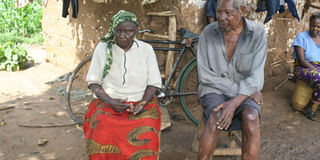How squatters became land owners in Lamu

Mr Johana Nyamita with Ms Wageci Nyamita at Umoja area Mpeketoni -Lamu County .William Oeri (Lamu)
What you need to know:
- “We were driven all the way to Mpeketoni after registering with the local administration in Thika as squatters. There was one big hall near Lake Kenyatta where we stayed, but we were lucky because the Cotton Board had cleared about 1,000 acres to grow cotton.”
Johana Nyamita and Alfred Mwaura have more in common than being neighbours at Umoja village in Mpeketoni, Lamu County.
They both arrived in Mpeketoni on the same day aboard a government lorry from Njiru, Thika, in 1972. They had been squatters at a farm neighbouring that of former President Jomo Kenyatta.
For more than 40 years, they have known Mpeketoni as their home and as they advance in age, they can only look back at the stroke of luck that turned them into land owners in a plot that has generated controversy and acrimony from thousands of indigenous people who claim to have received a raw deal from the government.
A lot has been said about the genesis of Lake Kenyatta Settlement Scheme, but one popular line is that of ‘tractors’ from Mount Kenya region.
It has almost become an adage that at one time when President Kenyatta visited Lamu, he asked locals what they wanted from him and his government, upon which the residents said they wanted tractors to cultivate the vast idle land.
“If it’s tractors that you want, then you will soon have them,” goes the story, but instead of bringing the machines, the founding President brought his kinsmen and gave them land.
Whether that is true or not, Mpeketoni, comprising lake Kenyatta I and Lake Kenyatta II settlement schemes and others in Witu and Hindi, has come a long way.
Mzee Nyamita, who is almost 90, and his neighbour Mwaura, a retired security officer, were in the first group of about 50 squatters from central Kenya to settle in Mpeketoni.
“We were driven all the way to Mpeketoni after registering with the local administration in Thika as squatters. There was one big hall near Lake Kenyatta where we stayed, but we were lucky because the Cotton Board had cleared about 1,000 acres to grow cotton.”
Return to Thika
“Our arrival was not without drama as some of our colleagues could not cope with the conditions and opted to return to Thika,” said Mr Mwaura.
The two elders lost close family members in the Mpeketoni attack that left 65 people dead.
Mr Mwaura said they did casual jobs for the Cotton Board before they were each allocated 20 acres, which was later reduced to 10 acres because of the growing number of settlers.
Although they found land already cleared for cultivation, adjusting to life at the Coast was not easy. The two men said they had arrived with their families, but there were no schools nearby. The nearest schools were in two Swahili villages; Mapenya and Mkunumbi, which were far.
After settling, Mr Nyamita said other groups followed from Kibra, Kirinyaga, Kawangware, Mwea and Nyandarua. However, some of the earlier settlers who went to Mpeketoni between 1974 and 1978 were living in Tanzania and were having problems with the Tanzanian government.
The story is however different for Mr Julius Kimotho, a peace activist who lost his disabled son during the attack. He received news that the government was giving free land in Mpeketoni.
“I was seated in a bar in Nakuru when a friend of mine walked in and started saying that there was land somewhere at the Coast.”
“I asked him to join me and even offered him a drink so that he could tell me more about the land. He said all one needed was to go to a chief to prove that he or she was landless and was ready to go to Mpeketoni,” recalls Mr Kimotho.
He went straight to the chief for a letter and after a few days, about 19 people left for the Coast.
On reaching Mombasa, they were met by Coast PC Eliud Mahihu who organised their transport to Mpeketoni.
Unlike the first group, they were taken to the forested areas, but with food support from the government. They started clearing the bush.
They also had to endure the dreaded Shifta menace, especially when they started harvesting farm produce and thriving.
Mwaura said the Shifta — a band of armed robbers — would raid a village and demand valuables, including money.
Mpeketoni is now a fast growing urban centre with modern buildings coming up. It has about five banks and is an important agricultural area that feeds Lamu and other towns such as Malindi, Mombasa and Garissa.
In spite of the growth, the settlement scheme has been seen by indigenous people as the epitome of historical injustices.
Some indigenous people claim they abandoned their farms at the height of Shifta attacks, while others say they still have their colonial title deeds.
Shifta war
They say the land was not idle as was claimed. They had been promised that the government would boost security so that they could move back to their land back, “but Kenyatta brought his people”.
Subsequent presidents brought in more people who already have title deeds, while the locals are still squatters, says a resident who did not want to be named.
Others claim the Shifta War was a government scheme to have locals abandon their farms to make it easy for the creation of a settlement scheme that left out the indigenous people.
However, even with the talk about unfair treatment of the locals by the government through favouritism of upcountry communities, there has never been any conflict.




